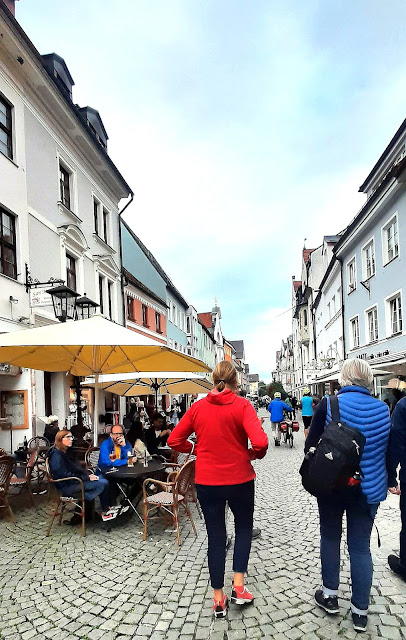Neuschwanstein Castle, located in Bavaria, Germany, is one of the most famous and iconic castles in the world. The distance from Penzberg was just 70kms hence this was our next one day trip which we
combined with a visit to Füssen that was just 5kms away from Neuschwanstein.
Neuschwanstein Castle, which means "New Swan Stone
Castle" in English, was constructed in the 19th century. It was
commissioned by King Ludwig II of Bavaria and was built as a retreat and homage
to the composer Richard Wagner, whose work greatly inspired the king. It
features a blend of architectural styles, including Romanesque and Gothic
Revival elements.
You can either walk it up to the castle (an easy stroll)
Take the bus
Or take the horse drawn carriage.
Construction of Neuschwanstein Castle began in 1869 and was never fully completed during Ludwig II's lifetime. The king lived in the castle for only a short time, and it remained incomplete at the time of his death in 1886.
It served as the inspiration for Disneyland's Sleeping Beauty Castle, and its fairy-tale appearance has made it an iconic symbol of German Romanticism.
The awe inspiring Neuschwanstein castle.
The Hohenschwangau Castle viewed from Neuschwanstein.
In addition to visiting Neuschwanstein Castle, the nearby
Hohenschwangau Castle, which was the childhood residence of King Ludwig II, is
also a popular attraction. The picturesque Alpsee Lake is in the vicinity,
offers opportunities for boating.
Hohenschwangau Castle, which means "High Swan County
Castle" in English, has a history dating back to the 12th century. It was
originally built as a fortress by the Knights of Schwangau and was later
expanded and renovated by various owners over the centuries. In the 19th
century, Hohenschwangau Castle was owned by Maximilian II of Bavaria, who was
King Ludwig II's father. The castle served as the royal summer residence for
the Bavarian royal family.
The castle is primarily built in the neo-Gothic and neo-Romanesque architectural styles. It features picturesque towers, turrets, and courtyards, making it an excellent example of Romantic-era architecture. King Ludwig II spent much of his childhood at Hohenschwangau Castle. His upbringing in this castle had a significant influence on his later architectural and artistic interests, which would lead him to commission Neuschwanstein Castle.
Due to its secluded and strategically unimportant location, the palace survived the destruction of the two World Wars. Until 1944, it served as a depot for Nazi plunder that was taken from France by the Reichsleiter Rosenberg Institute for the Occupied Territories (Einsatzstab Reichsleiter Rosenberg für die besetzten Gebiete), a suborganisation of the Nazi Party. In April 1945, the SS considered blowing up the palace to prevent the building and the artwork it contained from falling to the enemy. The plan was not realised by the SS-Gruppenführer who had been assigned the task, and at the end of the war the palace was surrendered undamaged to representatives of the Allied forces. The Allied occupation authorities eventually returned the palace to the reconstituted Bavarian state government.
Füssen beckoned and off we headed to visit yet another pretty town of Bavaria!
Füssen's Old Town is a charming area with cobblestone streets, colorful buildings, and historic churches. St. Mang's Basilica is a notable church worth visiting.
The St. Mang Basilica, also known as St. Mang's Church (St. Mangkirche in German), is one of the prominent landmarks in Füssen and is known for its historical and architectural significance.
The church is named after St. Mang, a Christian martyr who lived during the 3rd century. St. Mang is considered the patron saint of Füssen, and the church was built to honor his memory. It is a fine example of Baroque architecture.
The church was built in the 18th century, with its exterior characterized by its stunning facade and a picturesque onion dome. The interior features ornate decorations and frescoes, making it a beautiful place of worship.
It hosts regular Catholic services and ceremonies.
The Brotbrunnen, also known as the "Bread Fountain," is a notable landmark in Füssen's Old Town. It was constructed in the late 16th century and served as a source of fresh drinking water for the townspeople. The name "Bread Fountain" is symbolic, and like similar fountains in other towns, it was associated with charity. In times of famine or scarcity, bread would be distributed to the needy from this fountain. It was a way to provide assistance to the less fortunate.
The Church of the Holy Spirit (Heilig-Geist-Spitalkirche) is a historic church that dates back to the 18th century constructed between 1747 and 1750. It is known for its beautiful Rococo architecture and hosts regular Catholic services and religious ceremonies.
Overall we had a fun day taking a walk down historic Bavaria and drove back to Penzberg in the evening. The commute back was pleasurable too!
































Hari Om
ReplyDeleteIt really is a most picturesque area, is it not?! You have some fabulous photographs here and do it justice. I love the Griffing candle stand! YAM xx
Amazing place, great photos
ReplyDeleteThank you Rupam 😊
DeleteGreat and interesting post! Thanks for sharing :)
ReplyDeleteThank you Petra. Pleasure to share 😊
DeleteWhat a delightful set of photographs to happen upon, this grey afternoon in the South of England. The first pic of the Neushwanstein Castle is exactly the image I needed to prod my Muse into action. :-)
ReplyDeleteThank you. Glad it prodded you into action!
DeleteThe castle as pictured in the clouds amid the greenery is a wonderful sight straight out of a child's fairytale.
ReplyDeleteAbsolutely!
DeleteLovely castle and cute town.
ReplyDeleteYes feels like wonderland :)
DeleteBeautiful photos of your trip. Thanks for sharing! (Now I want to go … 😊)
ReplyDeleteThank you. You must! :)
DeleteLovely and amazing photos
ReplyDeleteYou can check out my latest post at this link:
https://www.melodyjacob.com/2023/10/the-blessing-in-emergency.html
Thank you. :)
DeleteThat is a lovely castle
ReplyDeleteHave a wonderful weekend!
You can view my new post here:
https://www.melodyjacob.com/2023/10/decoding-instagrams-modesty-debate-are-revealing-trends-empowering-or-indecent.html